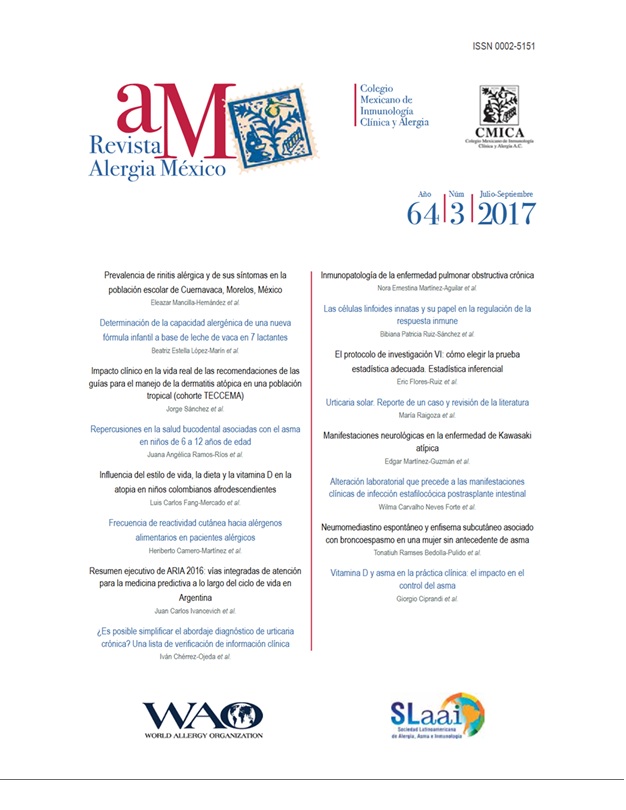Resumen
Antecedentes: Se considera que la alergia alimentaria tiene una prevalencia mundial de 2 a 10 %.
Objetivo: Determinar la frecuencia de reactividad cutánea hacia alérgenos alimentarios por grupos de edad.
Métodos: Estudio observacional, descriptivo, transversal y prolectivo. Se incluyeron pacientes de 2 a 64 años de edad con cuadro compatible de enfermedad alérgica. Se efectuaron pruebas por punción cutánea con alérgenos alimentarios. Se estimaron frecuencias y porcentajes.
Resultados: Se incluyeron 191 pacientes, 63.4 % fue del sexo femenino. La edad promedio fue 22.5 años; 19.3 % mostró reactividad cutánea positiva al menos a un alimento. La distribución por grupo etario fue la siguiente: preescolares 13.5 %, escolares 24.3 %, adolescentes 2.7 % y adultos 59.5 %. Los diagnósticos fueron rinitis alérgica 84.3 %, asma 19.4 %, urticaria 14.1 % y dermatitis atópica 8.4 %. La distribución de la frecuencia de reactividad cutánea positiva en orden descendente fue 5.2 % a soya, 4.7 % a durazno, 3.6 % a uva, naranja y manzana, 3.1 % a nuez y 2.6 % a piña, aguacate, tomate y atún.
Conclusión: La frecuencia de reactividad cutánea para alérgenos alimentarios fue similar a la informada en la literatura nacional y latinoamericana, pero la sensibilización para cada alérgeno específico varió en cada grupo etario.
Referencias
Nowak-Wegrzyn A, Burks W, Sampson H. Reactions to Foods. En: Adkinson N, Bochner B, Burks A, Busse W, Holgate S, Lemanske R, et al. Middleton’s Allergy: Principles and Practice. Volumen II. Octava edición. USA: Mosby; 2014. p. 1310-1335.
Burks AW, Jones SM, Boyce JA, Sicherer SH, Wood RA, Assa’ad A, et al. NIAID-sponsored 2010 guidelines for managing food allergy: applications in the pediatric population. Pediatrics. 2011;128(5):955-965. DOI: http://dx.doi.org/10.1542/peds.2011-0539
Burks AW, Tang M, Sicherer S, Muraro A, Eigenmann PA, Ebisawa M, et al. ICON: food allergy. J Allergy Clin Immunol. 2012;129(4):906-920. DOI: http://dx.doi.org/10.1016/j.jaci.2012.02.001
Fiocchi A, Sampson HA, Bahna SL, Lack G. Food Allergy. En: Pawankar R, Canonica GW, Holgate ST, Lockey RF, editores. WAO White Book on Allergy. USA: World Allergy Organization; 2013. p. 47-52.
Shek LP, Cabrera-Morales EA, Soh SE, Gerez I, Ng PZ, Yi FC, et al. A population-based questionnaire survey on the prevalence of peanut, tree nut and shellfish allergy in 2 Asian populations. J Allergy Clin Immunol. 2010;126(2):324-331. DOI: http://dx.doi.org/10.1016/j.jaci.2010.06.003
Rodríguez-Ortiz P, Muñoz-Mendoza D, Arias-Cruz A, González-Díaz SN, Herrera-Castro D, Vidaurri-Ojeda AC. Características epidemiológicas de pacientes con alergia a alimentos atendidos en el Centro Regional de Alergias e Inmunología Clínica de Monterrey. Rev Alerg Mex. 2009;56(6):185-191.
Chapman JA, Bernstein IL, Lee RE, Oppenheimer J, Nicklas RA, Portnoy JM, et al. Food allergy: A practice parameter. Ann Allergy Asthma Immunol. 2006;96(3 Suppl 2):1-68.
Nwaru BI, Hickstein L, Panesar SS, Roberts G, Muraro A, Sheikh A, et al. Prevalence of common food allergies in Europe: a systematic review and meta-analysis. Allergy. 2014;69(8):992-1007. DOI: http://dx.doi.org/10.1111/all.12423
Sicherer SH. Epidemiology of food allergy. J Allergy Clin Immunol. 2011;127(3):594-602. DOI: http://dx.doi.org/10.1016/j.jaci.2010.11.044
González-Díaz S, Arias-Cruz A, Domínguez-Sansores LA, Galindo-Rodríguez G, Leal-Villareal L, Canseco-Villareal JI, et al. Sensibilización a alérgenos alimentarios en pacientes del Servicio de Alergia del Hospital Universitario de la UANL, Monterrey. Med Univer. 2013;15(59):59-63.
Sicherer SH, Sampson HA. Food allergy: Epidemiology, pathogenesis, diagnosis and treatment. J Allergy Clin Immunol. 2014;133(2):291-307;quiz 308. DOI: http://dx.doi.org/10.1016/j.jaci.2013.11.020
Berin MC. Mechanisms of allergic sensitization to foods: bypassing immune tolerance pathways. Immunol Allergy Clin North Am. 2012;32(1):1-10. DOI: http://dx.doi.org/10.1016/j.iac.2011.10.001
Soares-Weiser K, Takwoingi Y, Panesar SS, Muraro A, Werfel T, Hoffmann-Sommergruber K, et al. The diagnosis of food allergy: a systematic review and meta-analysis. Allergy. 2014;69(1):76-86. DOI: http://dx.doi.org/10.1111/all.12333
Boyce JA, Assa’ad A, Burks AW, Jones SM, Sampson HA, Wood RA, et al. Guidelines for the diagnosis and management of food allergy in the United States: Report of the NIAID-sponsored expert panel. J Allergy Clin Immunol. 2010;126(60):1-58. DOI: http://dx.doi.org/10.1016/j.jaci.2010.10.007
Eigenmann PA, Jae-Won O, Beyer K. Diagnostic testing in the evaluation of food allergy. Pediatr Clin N Am. 2011;58(2):351-362. DOI: http://dx.doi.org/10.1016/j.pcl.2011.02.003
Nolte H, Kowal K, DuBuske L. Overview of skin testing for allergic disease. Disponible en: http://cursoenarm.net/UPTODATE/contents/mobipreview.htm?2/4/2113?source=HISTORY
Heinzerling L, Mari A, Bergmann KC, Bresciani M, Burbach G, Darsow U, et al. The skin prick test-European standards. Clin Transl Allergy. 2013;3(1):1-10. DOI: http://dx.doi.org/10.1186/2045-7022-3-3
Cianferoni A, Spergel JM. Food allergy; review, classification and diagnosis. Allergol Int. 2009;58(4):457-466. DOI: http://dx.doi.org/10.2332/allergolint.09-RAI-0138
Medina-Hernández A, Huerta-Hernández RE, Góngora-Meléndez MA, Domínguez-Silva MG, Mendoza-Hernández DA, Romero-Tapia SJ, et al. Perfil clínico-epidemiológico de pacientes con sospecha de alergia alimentaria en México. Estudio Mexipreval. Rev Alerg Mex. 2015;62(1):28-40. Disponible en: revistasmedicasmexicanas.com.mx/nieto/Alergia/2015/ene-mar/art.original_perfil.pdf
Sánchez J, Sánchez A. Epidemiology of food allergy in Latin America. Allergol Immunopathol (Madr). 2015;43(2):185-195. DOI: http://dx.doi.org/10.1016/j.aller.2013.07.001
Bedolla-Barajas M, Bedolla-Pulido TR, Camacho-Peña AS, González-García E, Morales-Romero J. Food hypersensitivity in Mexican adults at 18 to 50 years of age: A questionnaire survey. Allergy Asthma Immunol Res. 2014;6(6):511-516. DOI: http://dx.doi.org/10.4168/aair.2014.6.6.511
Maya-Epelstein J, Rosas-Vargas MA, Del-Río-Navarro B. Frecuencia de sensibilización a alimentos por pruebas cutáneas de prick-to-prick de parche en niños con enfermedades alérgicas. Rev Alerg Mex. 2012;59(3):123-130.

Esta obra está bajo una licencia internacional Creative Commons Atribución-NoComercial 4.0.
Derechos de autor 2017 Revista Alergia México





